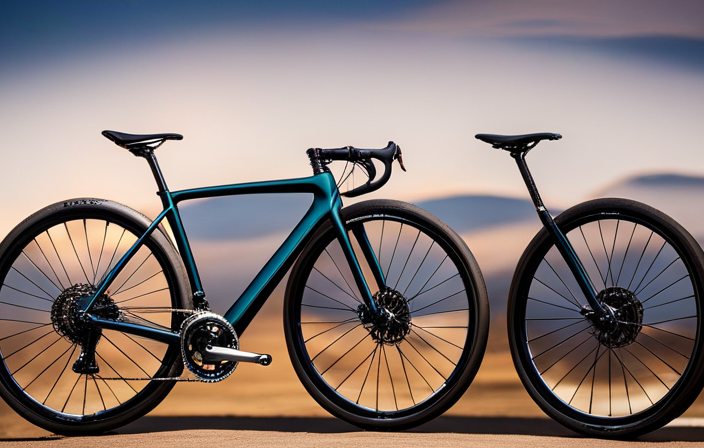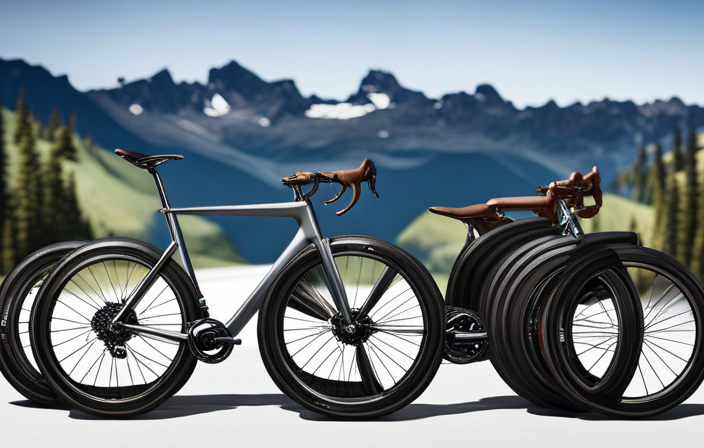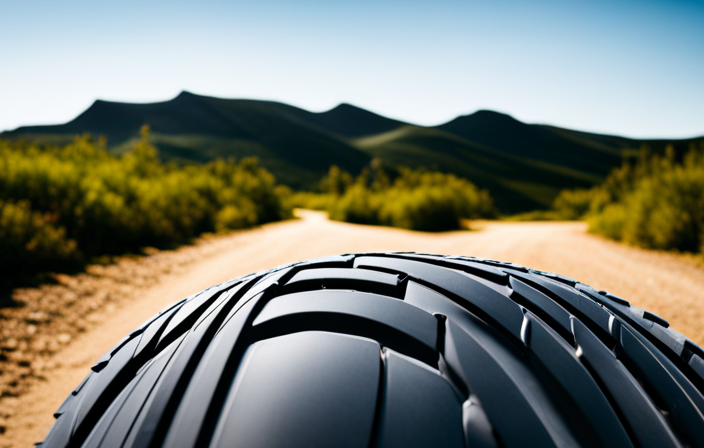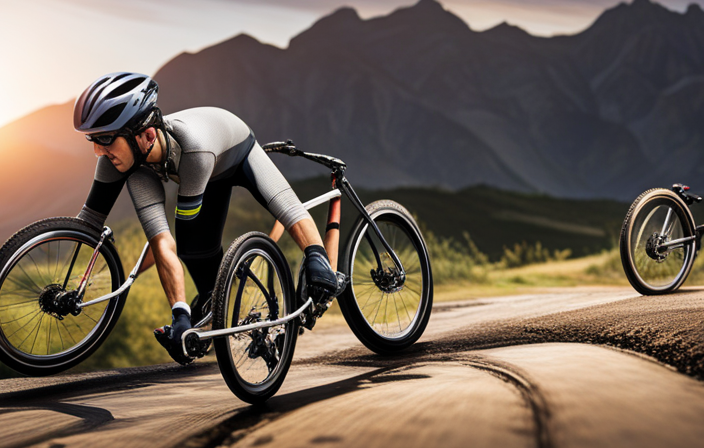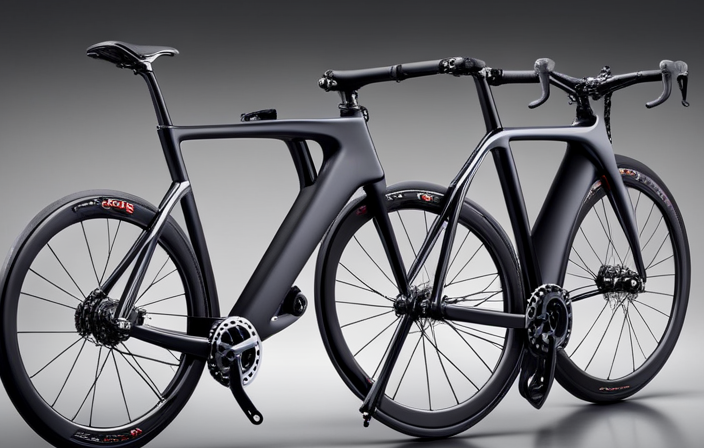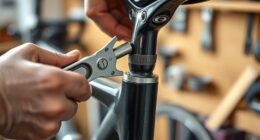Imagine yourself cruising down a rough gravel path, feeling the wind on your face and the excitement of adventure running through your veins. While handling the twists and turns, one question lingers: how wide should your gravel bike handlebars be?
Finding the perfect width is crucial for optimal comfort and control. In this article, we’ll delve into the factors to consider – body geometry, terrain conditions, and riding style – to help you make an informed decision.
So saddle up as we explore the pros and cons of wide versus narrow handlebars in gravel biking.
Key Takeaways
- Handlebar width impacts body positioning and overall comfort
- Wider handlebars provide stability and control in unpredictable terrain
- Shoulder width determines suitable handlebar width
- Terrain and riding style influence handlebar width choice
Understanding the Importance of Handlebar Width in Gravel Biking
You should understand why handlebar width is important in gravel biking. The width of your handlebars plays a crucial role in determining your body positioning on the bike and can greatly impact your overall comfort and performance. When it comes to gravel biking, where you encounter various terrains and ride for long durations, having the right handlebar width is essential.
One key consideration is body positioning. Wider handlebars provide more stability and control, allowing you to confidently navigate through unpredictable terrain. They also promote a wider stance, which helps distribute your weight evenly across the bike, improving balance and reducing the risk of crashing.
Another important factor is hand fatigue. Riding on rough gravel roads can be jarring, causing vibrations that can lead to discomfort and numbness in your hands over time. Opting for wider handlebars helps absorb these vibrations better, reducing strain on your hands and minimizing fatigue during longer rides.
In conclusion, choosing the correct handlebar width for gravel biking is vital for maintaining optimal body positioning and preventing hand fatigue. Now let’s consider your body geometry and riding style as we delve into finding the perfect handlebar width for you.
Consider Your Body Geometry and Riding Style
When considering your body geometry and riding style, it’s important to take into account the width of your handlebars. Your body positioning on the bike plays a crucial role in how comfortable and efficient you are while riding. The width of your handlebars can greatly affect your body position and bike handling techniques.
To determine the optimal handlebar width for you, it’s essential to consider several factors. First, think about your shoulder width. A wider handlebar may be more suitable for riders with broader shoulders as it allows for better leverage and stability when maneuvering through rough terrain. Conversely, narrower handlebars are generally preferred by riders with narrower shoulders as they provide a more aerodynamic position.
Secondly, consider your riding style. If you prefer a more aggressive riding position, wider handlebars can give you greater control over the bike and improve stability during fast descents or technical sections. On the other hand, if you prioritize long-distance comfort or have a more relaxed riding style, narrower handlebars may be more suitable.
By taking these factors into account and selecting the appropriate handlebar width based on your body geometry and riding style, you can achieve optimal comfort and control on your gravel bike without compromising performance or safety.
Achieving Optimal Comfort and Control
To achieve optimal comfort and control, it’s important to consider factors such as body positioning, riding style, and the width of your handlebars. When it comes to gravel bike handlebars, finding the right width can greatly impact your overall riding experience.
Here are three key considerations for achieving optimal hand positioning and reducing hand fatigue:
-
Ergonomics: Handlebar width should allow for a natural alignment of your hands, wrists, and arms. Optimal hand positioning promotes better control over the bike and reduces strain on your upper body.
-
Riding Style: The type of terrain you ride on plays a role in determining handlebar width. For technical off-road trails or singletrack, wider handlebars provide more stability and control. On the other hand, narrower bars are preferred for long-distance endurance rides on smoother surfaces.
-
Personal Preference: Ultimately, comfort is subjective and what works for one rider may not work for another. Experimenting with different handlebar widths can help you find the sweet spot that suits your individual needs.
By considering these factors when choosing gravel bike handlebars, you can find the right balance between stability and maneuverability. This ensures an enjoyable riding experience while minimizing hand fatigue.
Finding the Right Balance Between Stability and Maneuverability
Finding the right balance between stability and maneuverability is crucial when selecting handlebars for your gravel bike. It’s important to consider the impact of handlebar width on bike handling dynamics.
Handlebars that are too wide can provide more stability but may compromise maneuverability, making it difficult to navigate tight turns or technical terrain. On the other hand, narrow handlebars offer increased agility but can reduce stability, especially at higher speeds or on rough surfaces.
To find the optimal balance, you need to take into account your riding style and preferences. If you prioritize stability over maneuverability, wider handlebars might be a better choice. They provide a broader base of support and help with maintaining control in challenging situations. However, if you value quick handling and responsiveness, narrower handlebars could be more suitable.
Additionally, it’s essential to evaluate the terrain and trail conditions where you’ll be riding most often. Steep descents or technical trails may require wider handlebars for improved stability during high-speed descents or navigating through obstacles. Conversely, if your rides consist mostly of smooth gravel roads or long-distance touring, narrower handlebars might suffice.
By finding the right balance between stability and maneuverability based on your riding style and terrain conditions, you can enhance your overall biking experience while maintaining control over your gravel bike without compromising its performance capabilities.
Evaluating the Terrain and Trail Conditions
Consider evaluating the terrain and trail conditions you’ll be riding on to determine the best handlebar choice for your gravel biking experience. Evaluating trail conditions is crucial in finding the right balance between stability and maneuverability. Adjusting handlebar width can greatly impact your control and comfort while riding.
Here are three factors to consider when evaluating trail conditions:
-
Trail Type: Different types of trails require different handlebar widths. For narrow singletrack trails, narrower handlebars provide better maneuverability through tight turns and obstacles. On the other hand, wider handlebars are beneficial for open and fast trails as they offer more stability.
-
Technicality: The level of technicality of the trail is an important aspect to consider when choosing handlebar width. More technical trails with rough terrain and frequent obstacles may benefit from wider handlebars to enhance stability and control.
-
Climbing vs Descending: Evaluate whether you will be doing more climbing or descending on your rides. Wider handlebars provide better leverage for descending, allowing for improved control and confidence at high speeds. Narrower bars, on the other hand, can make climbing easier by providing a more aerodynamic position.
Taking into account shoulder width and arm position will further help in determining the ideal handlebar width for your gravel bike setup.
Taking Into Account Shoulder Width and Arm Position
Evaluate your shoulder width and arm position in order to determine the ideal width for your handlebars. Body positioning plays a crucial role in achieving optimal comfort and control while riding a gravel bike. When it comes to handlebar width, it’s important to consider ergonomic considerations that match your body proportions.
To assess your shoulder width, stand upright with your arms relaxed at your sides. Measure the distance between the bony prominences of both shoulders. This measurement will give you an idea of how wide or narrow your handlebars should be.
Additionally, take into account your arm position when riding. Some riders prefer a more relaxed and natural arm position, while others may benefit from a slightly wider handlebar that allows for better leverage during technical maneuvers.
Incorporate these findings into the table below:
| Shoulder Width | Ideal Handlebar Width |
|---|---|
| Narrow | 40-42cm |
| Average | 42-44cm |
| Wide | 44-46cm |
By considering both shoulder width and arm position, you can find the perfect balance between comfort and control on your gravel bike. Once you have determined an initial ideal handlebar width based on these factors, you can proceed to test different widths for personal preference without altering this essential starting point.
Testing Different Handlebar Widths for Personal Preference
Once you’ve determined your initial ideal handlebar width based on shoulder width and arm position, you can start testing different widths to find the one that suits your personal preference. Testing different handlebar widths is crucial in finding optimal comfort while riding a gravel bike. It allows you to fine-tune your setup and ensure that your bike fits you perfectly.
To begin the testing process, it’s recommended to start with a slightly narrower or wider handlebar than your initial ideal width. For example, if your initial measurement suggests a 42cm handlebar, try using a 40cm or 44cm bar instead. This will provide contrasting experiences and help identify which width feels more comfortable for you.
During each test ride, pay close attention to how the different handlebar widths affect your body position and overall comfort. Consider factors such as hand positioning, wrist angle, and ease of maneuverability. Take note of any discomfort or strain in your shoulders, arms, or wrists.
Once you have tested multiple handlebar widths and found one that offers the best balance of comfort and control for you personally, it’s time to consider other aspects of choosing the right gravel bike setup. These considerations include factors like considering the type of gravel bike and its intended use without compromising on safety or functionality.
Considering the Type of Gravel Bike and its intended use
When choosing the right type of gravel bike, it’s important to think about its intended use and how it will fit your needs. Considering bike geometry is crucial in determining the appropriate handlebar width for your gravel bike. Different types of gravel bikes have varying geometries that affect their handling and performance on different terrains.
For example, a more aggressive or racing-oriented gravel bike may have a narrower handlebar to provide better aerodynamics and maneuverability, while a more adventure-focused bike might have a wider handlebar for improved stability and control on rougher terrain.
In addition to considering the type of gravel bike, evaluating suspension options is also essential when deciding on handlebar width. Gravel bikes can come with different suspension setups, such as rigid forks or front suspension forks. The presence of suspension can influence how much feedback you get through the handlebars, which may affect your preference for wider or narrower bars.
When considering both bike geometry and suspension options, take into account your riding style and preferences. A wider handlebar may offer better leverage for technical descents or off-road sections, while a narrower one might be more suitable for long-distance rides where comfort and aerodynamics are priorities.
To further fine-tune your decision on handlebar width, it’s helpful to consult with experts and experienced gravel bikers who can provide valuable insights based on their knowledge and personal experiences.
Consulting with Experts and Experienced Gravel Bikers
To get the best advice on choosing the right handlebar width for your gravel bike, it’s worth reaching out to experts and experienced gravel bikers who can offer valuable insights based on their knowledge and personal experiences. These individuals have spent countless hours riding different types of terrain and experimenting with various handlebar widths to find what works best for them.
When consulting with experts and experienced gravel bikers, they can provide guidance on how body positioning plays a crucial role in determining the appropriate handlebar width. They understand that the width of the handlebars affects how you position your body on the bike, which ultimately impacts your comfort and control while riding. They can also share bike handling techniques that are specific to different handlebar widths, allowing you to make an informed decision based on your desired riding style.
In addition to seeking advice from these knowledgeable sources, it can be helpful to reference a table that outlines recommended handlebar widths based on rider height and preference. This table provides a comprehensive overview of options available, giving riders a starting point when considering their own needs.
By consulting with experts and experienced gravel bikers, as well as referencing resources like tables, riders can gain valuable insights into choosing an appropriate handlebar width for their gravel bike. This information sets the foundation for customizing handlebar width to individual needs in order to optimize comfort and performance without compromising safety or control.
Customizing Handlebar Width for Individual Needs
Customizing the width of your handlebars is essential for meeting individual comfort and performance needs on a gravel bike. When it comes to gravel riding, there are various custom handlebar options available that allow you to find the perfect fit for your body and riding style.
One option to consider is narrow handlebars. While wider bars provide more stability and control, narrow handlebars have their own benefits. They can help improve aerodynamics, making it easier to cut through wind resistance on long rides or during races. Additionally, narrower bars can make maneuvering through tight spaces or technical sections of a trail easier.
When customizing your handlebar width, it’s important to find the right balance between comfort and control. You don’t want them too wide that it strains your shoulders or restricts your movement, but also not too narrow that it compromises stability.
In the next section about avoiding common mistakes in choosing handlebar width, we will explore some key considerations to keep in mind when selecting the optimal width for your gravel bike setup.
Avoiding Common Mistakes in Choosing Handlebar Width
One common mistake is not considering the balance between comfort and control when choosing the width of your handlebars. It’s important to find a width that allows for proper body position, as well as reduces hand fatigue during long rides. Here are some key points to consider:
-
Body Position: The width of your handlebars should allow for a comfortable and natural body position while riding. If the bars are too wide, it can cause strain on your shoulders and neck. On the other hand, if they’re too narrow, it can limit your control over the bike.
-
Hand Fatigue: Choosing handlebars that are too wide or too narrow can lead to hand fatigue during longer rides. It’s essential to find a width that allows you to grip the bars comfortably without straining your hands or wrists.
-
Control: Handlebar width plays a significant role in controlling your bike. Wider bars offer more stability and control over rough terrain, while narrower ones provide better maneuverability in tight spaces.
-
Personal Preference: Ultimately, finding the right handlebar width is also a matter of personal preference. Some riders may prefer wider bars for added stability, while others might opt for narrower ones for increased agility.
Considering these factors will help you avoid common mistakes when choosing handlebar width and ensure a more enjoyable riding experience. In the next section about adapting to different riding situations with adjustable handlebars, we’ll explore ways to customize your setup even further without compromising comfort or control.
Adapting to Different Riding Situations with Adjustable Handlebars
Adapting to different riding situations can be made easier with adjustable handlebars. One of the benefits of adjustability is that it allows you to customize your bike’s handling based on the terrain or conditions you’ll be riding in.
For example, if you’re tackling a technical off-road trail, you can widen the handlebars for more stability and control. On the other hand, if you’re riding in a narrow urban setting, you can narrow the handlebars for better maneuverability through tight spaces.
Adjustable handlebars also allow you to fine-tune your riding position for optimal comfort and efficiency. Being able to adjust the width of your handlebars can help alleviate strain on your shoulders and wrists, especially during long rides. It also allows you to find a position that suits your body type and riding style, ensuring a more enjoyable experience on the bike.
In addition, adjustable handlebars provide versatility for riders who may need to share their bike with others. By easily adjusting the width, different riders can find a comfortable fit without needing multiple bikes or extensive adjustments.
Exploring the pros and cons of wide and narrow handlebars will further help in determining the ideal width for gravel bike handlebars without compromising safety or performance.
Exploring the Pros and Cons of Wide and Narrow Handlebars
When exploring the pros and cons of different handlebar widths, you’ll want to consider how they can affect your riding experience. Finding the ideal handlebar width for your gravel bike is crucial in ensuring a comfortable and efficient ride.
Wide handlebars offer several advantages. Firstly, they provide better stability and control, especially when navigating rough terrains or descending at high speeds. Wide handlebars also allow for increased leverage, making it easier to maneuver the bike through technical sections. Additionally, they offer more space for mounting accessories like lights, GPS units, or bags.
However, there are potential drawbacks of wide handlebars that need to be considered. One issue is that wider bars may limit your ability to navigate tight spaces or weave through narrow trails. They can also place excess strain on your shoulders and upper body if they are too wide for your specific body dimensions.
To ensure proper bike fit and ergonomics, it’s important to find a balance between width and comfort. This involves considering factors such as shoulder width, riding style, and the type of terrain you will be primarily riding on.
Transitioning into the subsequent section about ‘ensuring proper bike fit and ergonomics’, it is vital to take all aspects into account when determining the right handlebar width for your gravel bike setup.
Ensuring Proper Bike Fit and Ergonomics
To ensure a proper fit and ergonomic setup on your gravel bike, it’s essential to consider factors such as body dimensions, riding style, and the type of terrain you’ll be encountering.
Customizing handlebar height is crucial in achieving comfort and control. A higher handlebar position can provide a more upright riding posture, which is ideal for long-distance rides or riders with back issues. On the other hand, a lower handlebar position may enhance aerodynamics and maneuverability for more aggressive riding styles or technical terrains.
Additionally, the importance of proper saddle position cannot be overstated. Finding the right saddle height and tilt will help distribute your weight evenly while pedaling and reduce strain on your lower back. It’s recommended to consult with a professional bike fitter who can assess your individual needs and make adjustments accordingly.
In summary, customizing handlebar height and ensuring proper saddle position are key elements in optimizing comfort and performance on your gravel bike. By taking these factors into account, you’ll be able to find the optimal setup that suits your body dimensions, riding style, and terrain preferences.
Emphasizing safety and stability in gravel biking requires attention to detail when it comes to bike fit – which we’ll explore further in the next section about emphasizing safety and stability in gravel biking without writing ‘step’.
Emphasizing Safety and Stability in Gravel Biking
One important aspect of riding on gravel is ensuring a stable and safe experience. This can be achieved through proper body positioning and equipment selection.
When it comes to body positioning, it is crucial to maintain a balanced and stable posture on the bike. This means keeping your weight centered and distributed evenly between the front and rear wheels. By doing so, you will be able to navigate through rough terrain with greater control and confidence.
In terms of equipment selection, one key component that plays a role in safety and stability is the width of the handlebars on your gravel bike. The appropriate handlebar width can greatly impact your overall riding experience. Generally, wider handlebars offer more control and stability, especially when tackling challenging terrain such as loose gravel or uneven surfaces.
However, it is important to find the right balance for your body size and riding style. Handlebars that are too wide may lead to discomfort or decreased maneuverability, while those that are too narrow may compromise stability.
To determine the ideal handlebar width for you, consider factors such as shoulder width, arm length, and personal preference. It may be helpful to consult with a professional bike fitter who can assess your individual needs and recommend an appropriate handlebar width based on your body measurements.
By prioritizing safety and stability through proper body positioning and equipment selection like handlebar width, you will enhance your overall gravel biking experience while minimizing potential risks or accidents along the way.
Frequently Asked Questions
What are the potential risks or drawbacks of using wide handlebars on a gravel bike?
Using wide handlebars on a gravel bike can have potential risks and drawbacks. One risk is reduced maneuverability, as wider bars can make it harder to navigate tight spaces or corners.
Another drawback is increased shoulder strain, especially for riders with narrower shoulders. Wide bars can also affect aerodynamics and increase wind resistance, resulting in slower speeds.
It’s important to consider these factors when choosing the width of your handlebars for optimal performance and comfort.
Can adjusting handlebar width improve overall bike handling and performance?
Adjusting handlebar width can indeed improve overall bike handling and performance. The height of the handlebars plays a crucial role in determining how well you can control the bike. Having the handlebars at the right height ensures proper weight distribution and optimal body position, allowing for better handling and maneuverability.
Additionally, the shape of the handlebars also impacts control and maneuverability. Different shapes offer varying hand positions and leverage, affecting steering responsiveness and stability.
Therefore, finding the right handlebar width is essential for maximizing your bike’s performance.
How does handlebar width impact upper body positioning and muscle engagement while riding?
When it comes to handlebar width, it has a significant impact on both upper body positioning and muscle engagement while riding.
The width of the handlebars can affect how your upper body is positioned on the bike, influencing your overall stability and control.
Additionally, the width also determines the level of muscle engagement in your shoulders, back, and arms.
Finding the right handlebar width that suits your body and riding style is crucial for optimal performance and comfort.
Are there any specific techniques or exercises that can help riders adapt to different handlebar widths?
To adapt to different handlebar widths, riders can benefit from specific techniques and exercises.
One technique is gradually increasing the width of the handlebars over time to allow for a more comfortable transition. This can be done by using handlebar extensions or swapping out different width options.
Additionally, practicing proper hand placement and grip on the handlebars can help riders adjust to wider widths by promoting stability and control while riding.
What are some common mistakes to avoid when choosing handlebar width for a gravel bike?
When choosing handlebar width for a gravel bike, it’s important to avoid some common mistakes.
One mistake is selecting handlebars that are too narrow or too wide for your body type and riding style. Narrow bars can cause discomfort and limit control, while wide bars may lead to shoulder strain.
Another mistake is not considering the terrain you’ll be riding on. For technical trails, wider bars provide better stability, but for long-distance rides, narrower bars offer better aerodynamics.
Conclusion
As I reflect on the importance of handlebar width in gravel biking, I am reminded of the delicate balance between comfort and control.
Just like a tightrope walker gracefully maneuvers their way across a thin wire, finding the right handlebar width allows us to navigate through challenging terrain with ease.
Whether wide or narrow, each option has its advantages and disadvantages.
Ultimately, it all comes down to personal preference and adapting to different riding situations.
So, embrace the handlebars that make you feel confident and secure, as safety and stability are paramount in the thrilling world of gravel biking.

